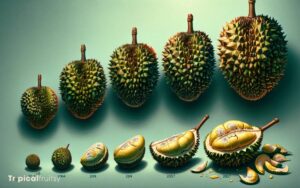How to Germinate Durian Seeds? 8 Easy Steps!
To germinate durian seeds, first, extract fresh seeds from ripe durian fruit. Soak them in water for 24 hours to enhance germination rates. Plant the seeds about 2 inches deep in rich, well-draining soil and keep the soil consistently moist.
Provide a warm environment with temperatures around 77-86°F (25-30°C) and partial sunlight. Germination typically occurs within a few days to several weeks, depending on conditions.
Germinating durian seeds requires several key steps to ensure success:
For example, after soaking a batch of durian seeds, you could plant them in individual pots filled with a mixture of compost and perlite to ensure proper moisture and nutrient levels.
Durian seeds demand patience and careful attention to detail during germination, but with the right conditions, they can flourish into the beloved producers of the “king of fruits.”
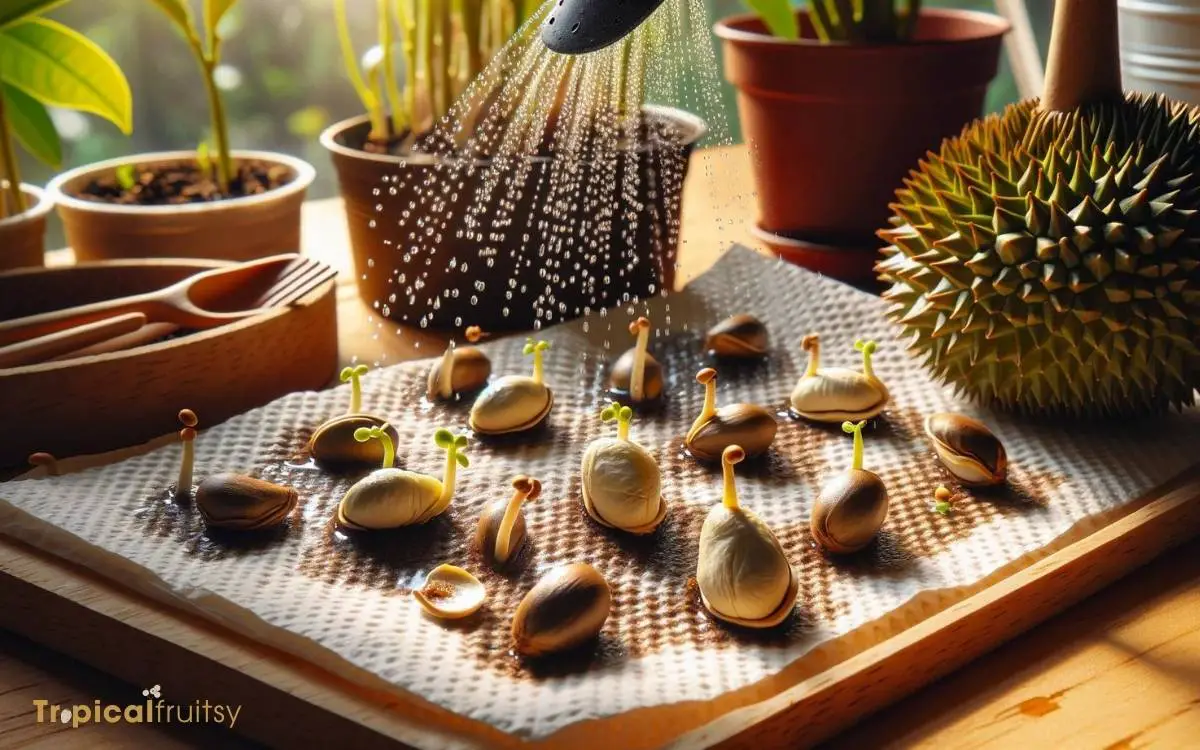
Key Takeaway
Understanding Durian Seeds
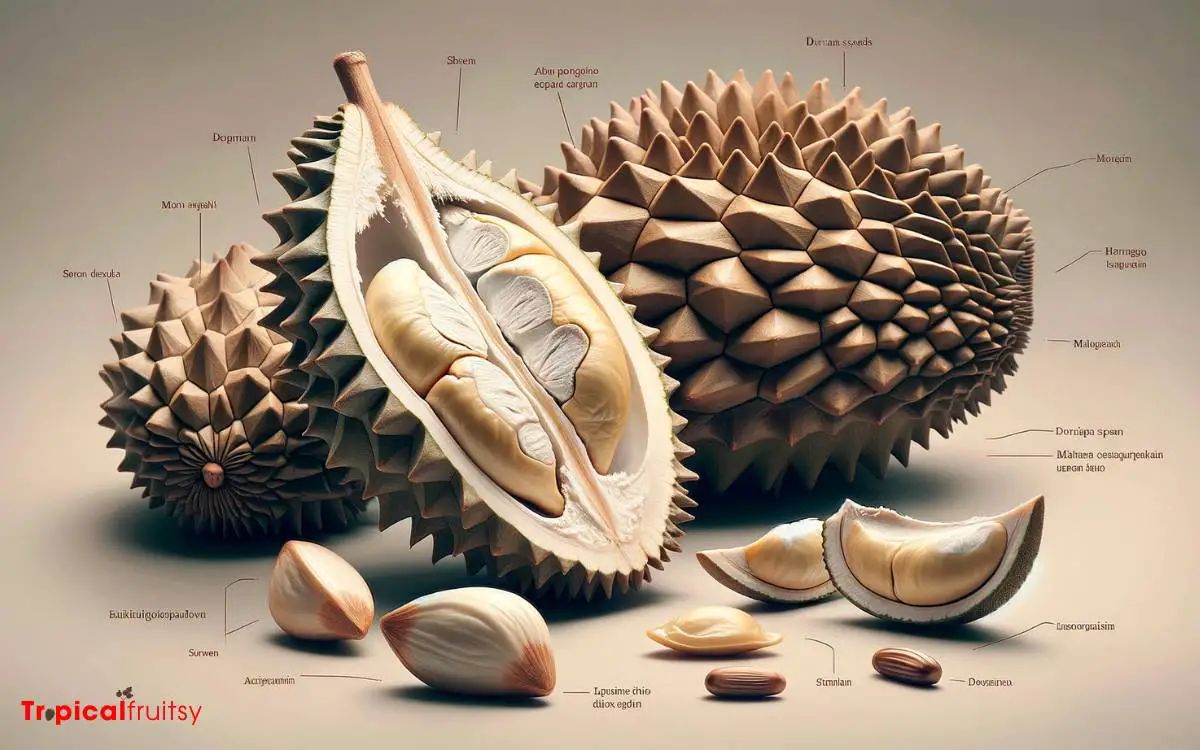
Before attempting to germinate durian seeds, it is crucial to comprehend their unique characteristics and requirements for successful sprouting.
Durian seeds possess a short viability span, necessitating prompt sowing after extraction from the fruit. The seeds are recalcitrant, which means they are sensitive to desiccation and cannot withstand drying or freezing.
Optimal germination occurs at temperatures between 25°C to 30°C, with high humidity levels being beneficial. The substrate for germination should be well-draining and rich in organic matter to support the initial growth phase.
A methodical approach includes maintaining consistent moisture without waterlogging, as durian seeds are prone to rot under excessive wet conditions.
Understanding these parameters sets the groundwork for the next critical step: selecting quality seeds that are viable and free from damage.
Step 1: Selecting Quality Seeds
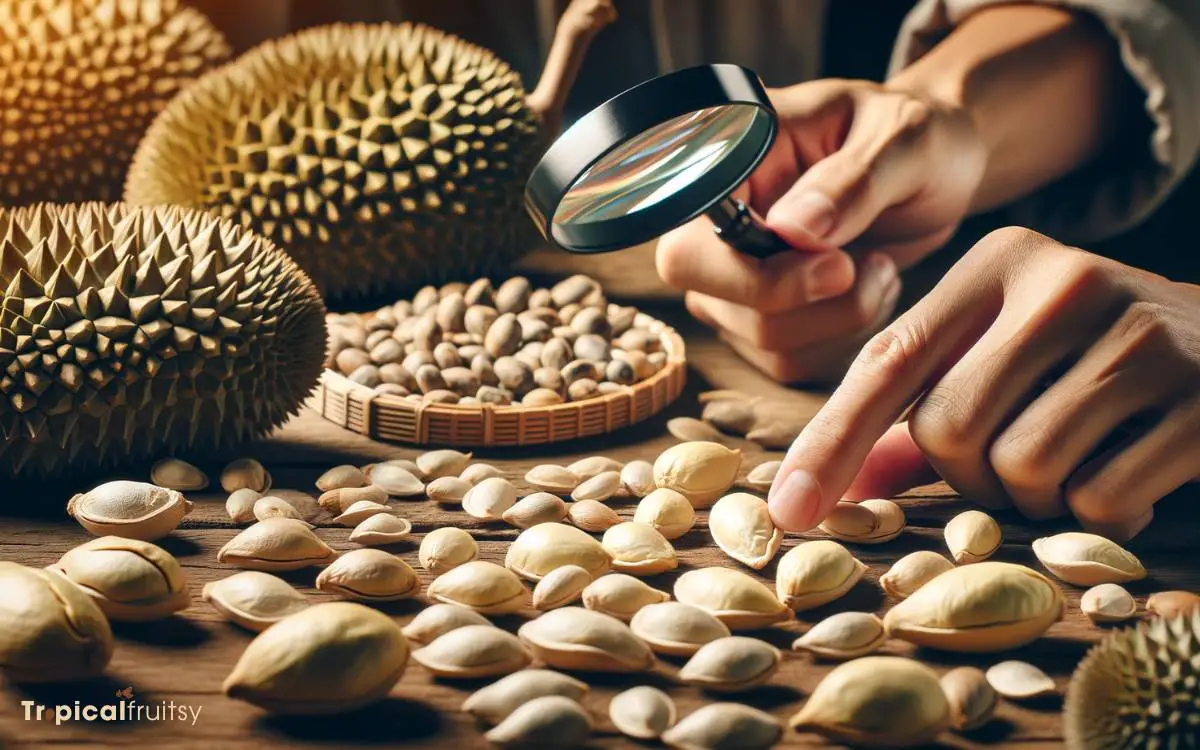
Selecting quality seeds is the first crucial step in the germination process of durian, as it directly influences the success rate of sprouting.
Optimal seed candidates should exhibit a plump and firm texture, with no signs of shriveling or discoloration, which may indicate desiccation or fungal contamination.
It is imperative to source seeds from fully matured durian fruit, as premature seeds possess inadequate endosperm development, compromising their viability.
Vigorously assess the seed’s weight; it should feel substantial for its size, suggesting a dense, nutrient-rich composition. Avoid seeds with surface blemishes or punctures that could predispose them to pathogens.
Utilize a float test by submerging seeds in water; viable seeds typically sink, whereas non-viable or hollow seeds float, indicating compromised integrity.
Step 2: Preparing the Seeds
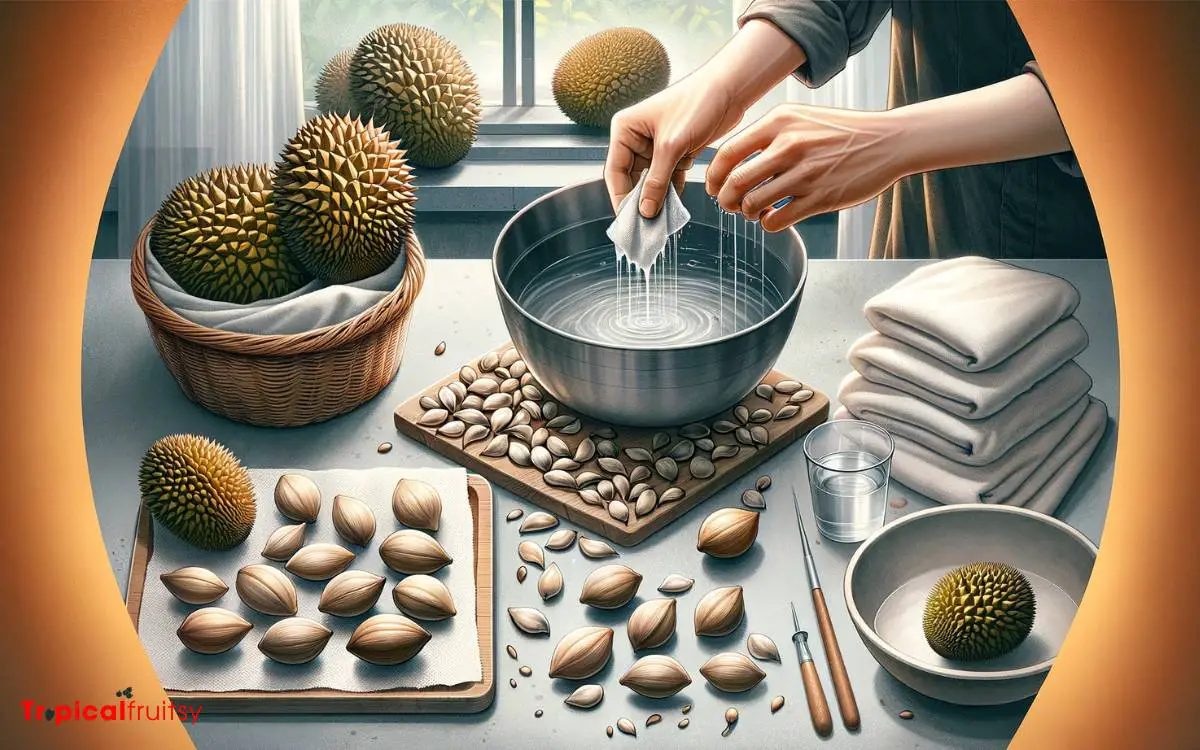
Having selected quality durian seeds, the next step is to prepare them for germination by cleaning and treating them to prevent fungal infections.
Initially, rinse the seeds thoroughly with distilled water to remove any adherent pulp and debris, as these can harbor pathogens.
Subsequently, immerse the seeds in a fungicidal solution or a natural antifungal agent such as a diluted cinnamon extract for a specified period, typically 10-15 minutes, to mitigate the risk of fungal contamination.
| Treatment Method | Emotional Impact |
|---|---|
| Rinsing with distilled water | Instills a sense of purity and meticulous care |
| Soaking in fungicide | Conveys a commitment to protecting the nascent life |
To ensure optimal results, maintain a sterile environment throughout the preparation process. Dry the seeds gently with a clean paper towel before moving to the sowing stage.
This meticulous preparation sets the foundation for robust germination and a gratifying horticultural journey.
Step 3: Choosing the Right Soil
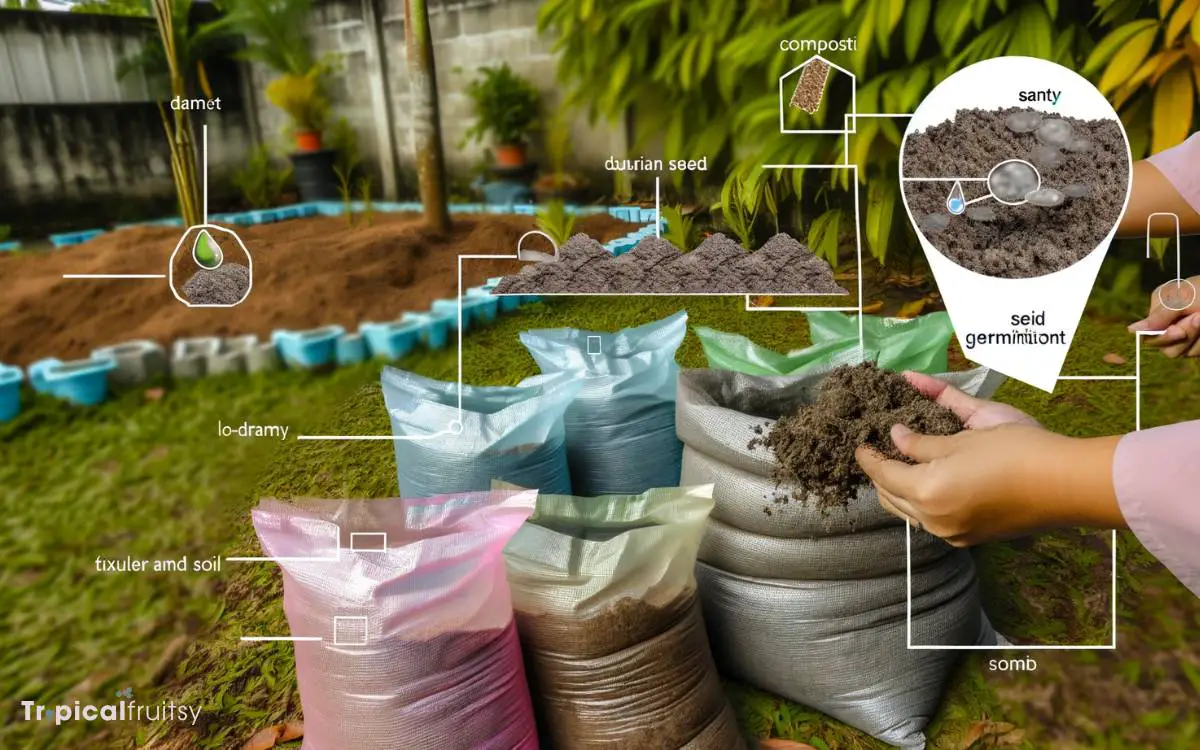
Selecting an appropriate substrate is critical for the successful germination of durian seeds. The soil’s pH level must be within the slightly acidic to neutral range, as this affects nutrient availability and root development.
Additionally, the presence of adequate organic matter is essential to ensure proper soil structure and moisture retention.
Soil Ph Levels
Considering the sensitivity of durian seeds to soil conditions, it is imperative to maintain a soil pH level between 6 and 7 for optimal germination.
This slightly acidic to neutral range facilitates the availability of essential nutrients crucial for the initial growth phase of the seedling.
To ascertain the pH level, one should conduct a soil analysis using a calibrated pH meter or pH test strips before sowing the seeds.
If the soil is too acidic (pH < 6), liming materials like calcitic or dolomitic limestone can be incorporated to raise the pH. Conversely, if the soil is too alkaline (pH > 7), elemental sulfur or aluminum sulfate may be applied to lower the pH.
Adjustments should be made gradually and retested to ensure the soil environment remains conducive to seed germination.
Organic Matter Content
After establishing the appropriate soil pH, it is essential to focus on the organic matter content of the soil, as rich, well-decomposed organic material provides the necessary nutrients and improves soil structure for the germination of durian seeds.
Ensuring optimal organic matter content involves:
- Incorporating compost or well-rotted manure to increase nutrient availability.
- Utilizing leaf mold or peat moss to enhance water retention and aeration.
- Integrating bone meal or blood meal to supply essential minerals like phosphorus and nitrogen.
- Adding earthworm castings to enrich the soil with microorganisms beneficial for root development.
These amendments should be methodically mixed into the topsoil to create a homogenous growing medium.
With the soil now enriched and conducive to growth, attention must shift to the precise methodology of sowing the seeds.
Step 4: Sowing the Seeds
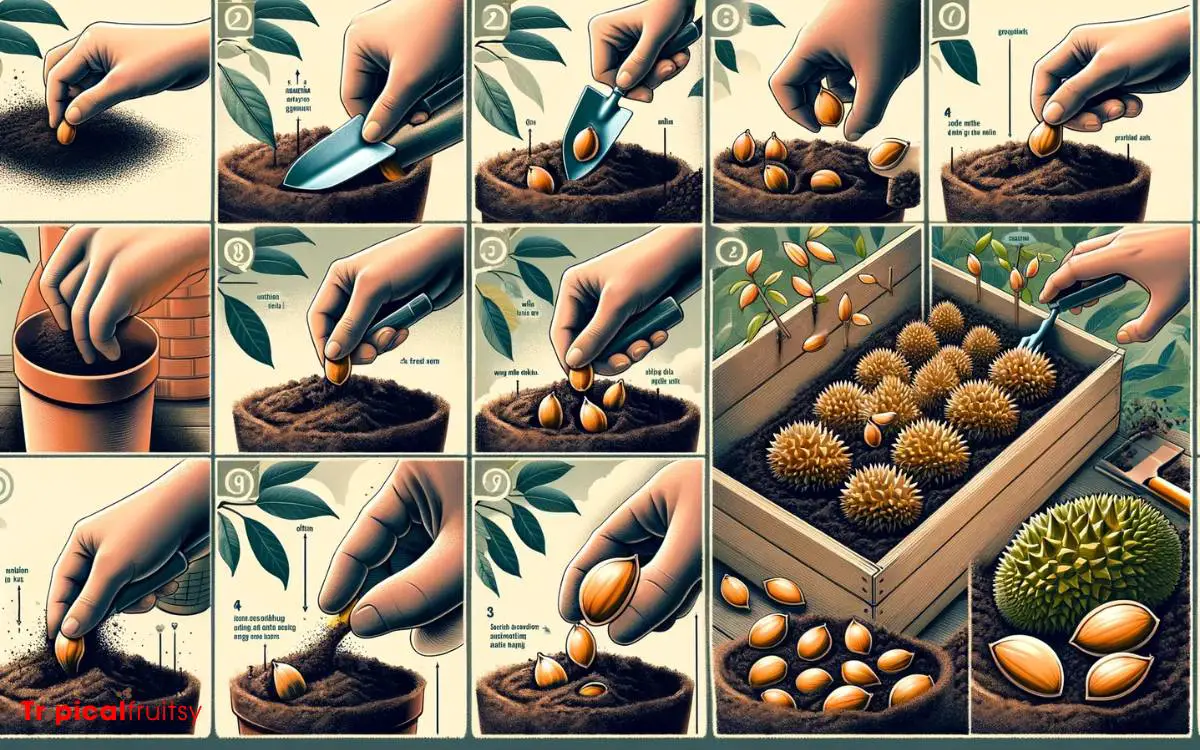
How does one effectively sow durian seeds to ensure successful germination? The process is meticulous, requiring specific conditions and careful handling.
Initially, prepare a soil medium with adequate drainage and a high organic matter content, as detailed in the previous subtopic. The pH should be mildly acidic to neutral.
Here is a table with critical parameters for sowing durian seeds:
| Step | Condition | Action |
|---|---|---|
| 1 | Soil Prep | Mix well-rotted compost with soil |
| 2 | Depth | Plant seeds 2-3 cm deep |
| 3 | Orientation | Place seeds flat-side down |
| 4 | Spacing | Space seeds 10 cm apart |
| 5 | Watering | Keep soil moist but not waterlogged |
After sowing, maintain a consistent temperature of 25-30°C. The timing of germination can vary, but under optimal conditions, seeds may sprout within 8 to 14 days.
Step 5: Optimal Germination Conditions

To ensure the successful germination of durian seeds, it is crucial to establish and maintain an environment that aligns with the species-specific physiological requirements.
A consistent temperature range, typically between 25°C to 30°C, must be sustained to optimize metabolic processes essential for germination.
Concurrently, precise soil moisture levels and appropriate light exposure are indispensable factors that contribute to the effective sprouting of durian seeds.
Temperature Range
Durian seeds require a consistent temperature range of 25-30°C (77-86°F) to achieve optimal germination conditions.
This specific thermal interval is critical for enzymatic processes that facilitate seed dormancy break and subsequent embryonic development.
Maintaining these temperatures is not merely a suggestion but rather an integral part of the germination protocol that directly influences the success rate and vigor of seedling growth.
- Maintain a steady thermal environment to prevent fluctuations that can stress the embryonic plant.
- Utilize temperature-controlled propagation mats or incubation chambers to ensure consistency.
- Monitor ambient temperatures with precision thermometers to detect and correct deviations.
- Shield the germination setup from external temperature influences, such as direct sunlight or drafts.
Soil Moisture Level
Maintaining an evenly moist substrate is essential for the successful germination of durian seeds. The ideal soil moisture level should be around 60-80% to ensure adequate hydration without causing waterlogging.
Precision in moisture regulation is paramount. Excessive dampness can lead to fungal infections and seed rot. On the other hand, insufficient moisture can result in the desiccation of the embryonic tissues.
To monitor and adjust the soil’s water content, employ a systematic approach. Use tools such as a moisture meter for accurate assessments. This will help ensure that the moisture level remains within the desired range.
Implement a consistent watering schedule. Ideally, use a fine mist to prevent the dislocation of seeds. This will help maintain a uniform moisture level and prevent any damage to the germinating seeds.
Consider the substrate’s composition and drainage capabilities. These factors significantly influence the retention and distribution of moisture within the germination medium.
Make sure that the substrate has good drainage to prevent waterlogging and allow excess water to escape.
Light Exposure Requirements
While durian seeds require warm temperatures for germination, direct sunlight should be avoided, as it can elevate soil temperatures excessively and damage the sensitive germinating tissues.
To provide optimal light exposure for durian seed germination, consider the following technical guidelines:
- Position seed trays in a location that receives indirect, filtered sunlight or utilize a shade cloth to diffuse direct sunlight.
- Monitor ambient light conditions regularly to ensure a consistent level of light exposure, avoiding any prolonged periods of darkness or intense light.
- Implement supplemental artificial lighting if natural light conditions are suboptimal, ensuring a spectral quality that closely mimics natural sunlight.
- Adjust light exposure based on the developmental stage of the germinated seedlings, gradually acclimating them to higher light intensities in preparation for eventual transplantation.
Step 6: Monitoring Seedling Growth
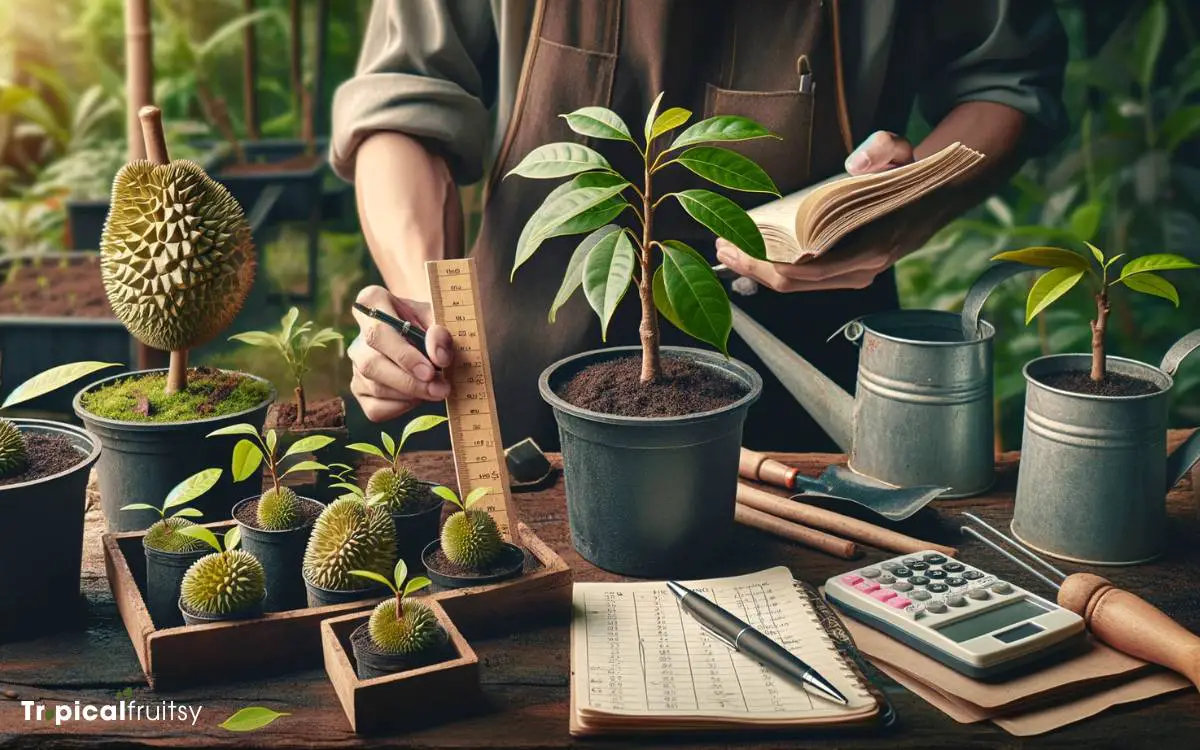
Once the durian seeds have successfully germinated, it is crucial to regularly monitor the growth and health of the emerging seedlings to ensure optimal development.
Vigilant observation should include a thorough assessment of foliar morphology, noting the color, texture, and integrity of leaves, which are indicative of nutritional adequacy and potential pathogenic challenges.
Stem elongation rates and girth measurements provide quantitative data on the vigor of seedlings, necessitating the use of calipers and a structured growth chart for precise tracking.
Additionally, scrutinize the substrate moisture levels and drainage efficiency, as durian seedlings are susceptible to root rot under waterlogged conditions.
Systematically document any anomalies or deviations from expected growth patterns, as these can preemptively signal the need for horticultural intervention.
Step 7: Transplanting Young Trees
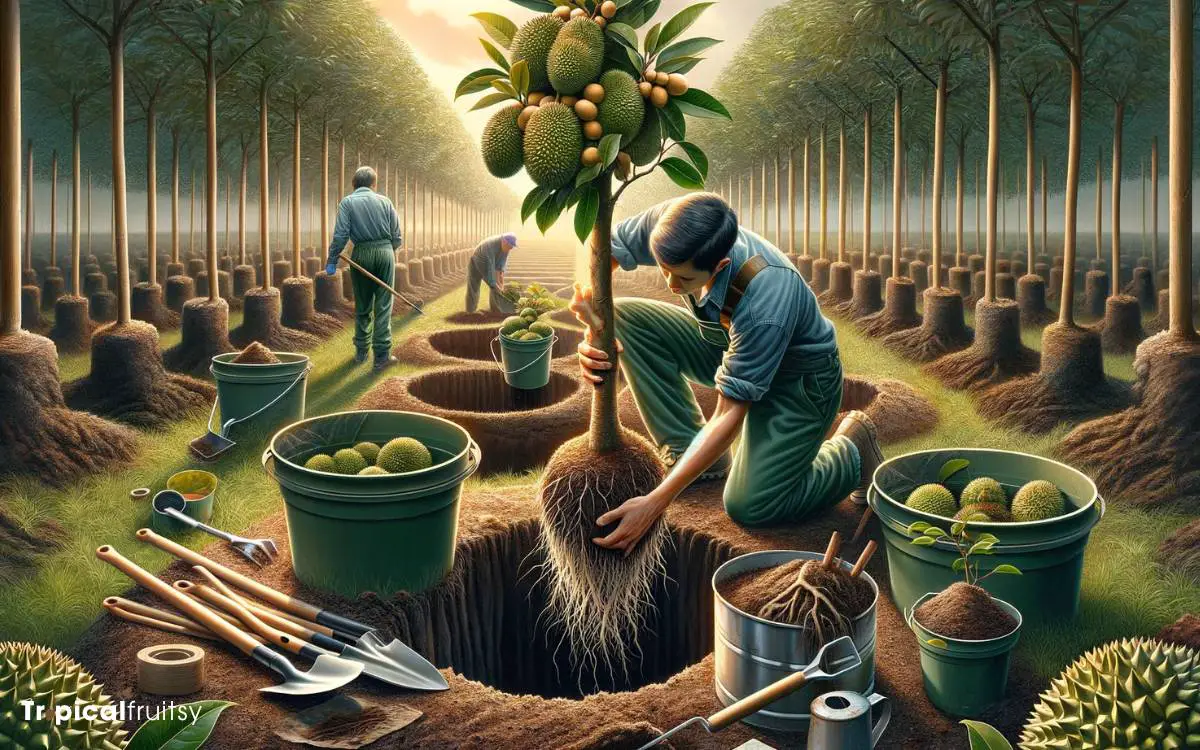
After the durian seedlings have established a robust root system and sufficient foliage, it is time to carefully plan their transplantation into larger pots or directly into the field.
The process must be executed with precision to ensure the young trees adapt smoothly to their new environment.
- Preparation of the Destination Site: Prioritize well-draining soil with high organic matter content, ensuring pH levels are between 6 and 7 for optimal nutrient uptake.
- Root Ball Management: Excavate a generous amount of soil around the seedling to preserve the root ball integrity during extraction.
- Transplant Timing: Perform transplantation during cooler parts of the day to minimize transplant shock and water stress.
- Post-Transplant Care: Establish a regular watering schedule, adjust for climatic conditions, and monitor for signs of distress.
Step 8: Durian Care Tips
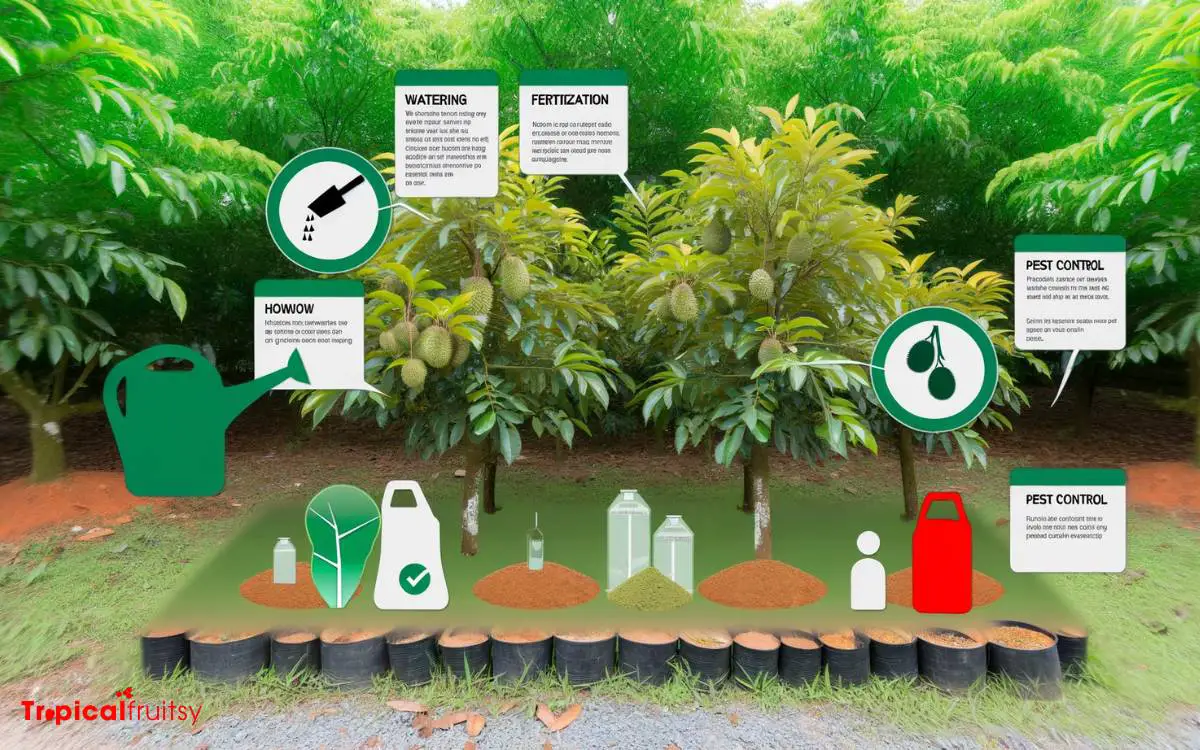
Upon successful germination and transplantation, durian trees require meticulous attention to watering, fertilization, and pest management to thrive.
To ensure optimal growth and fruit production, a strict regimen must be adhered to, taking into account the specific needs of the durian tree at various stages of its development.
The following table provides a concise overview of the essential care practices:
| Aspect | Considerations |
|---|---|
| Watering | Regular and deep watering, allowing soil to dry in between |
| Fertilization | Balanced NPK ratio during growth, increased Potassium during fruiting |
| Pruning | Remove dead or diseased branches, shape canopy for even growth |
| Pest Control | Monitor for common pests such as mites and beetles, use appropriate organic or chemical treatments |
Implementing these care tips methodically will foster a healthy durian tree capable of yielding delectable fruits.
How to Grow Durian from Frozen Seed
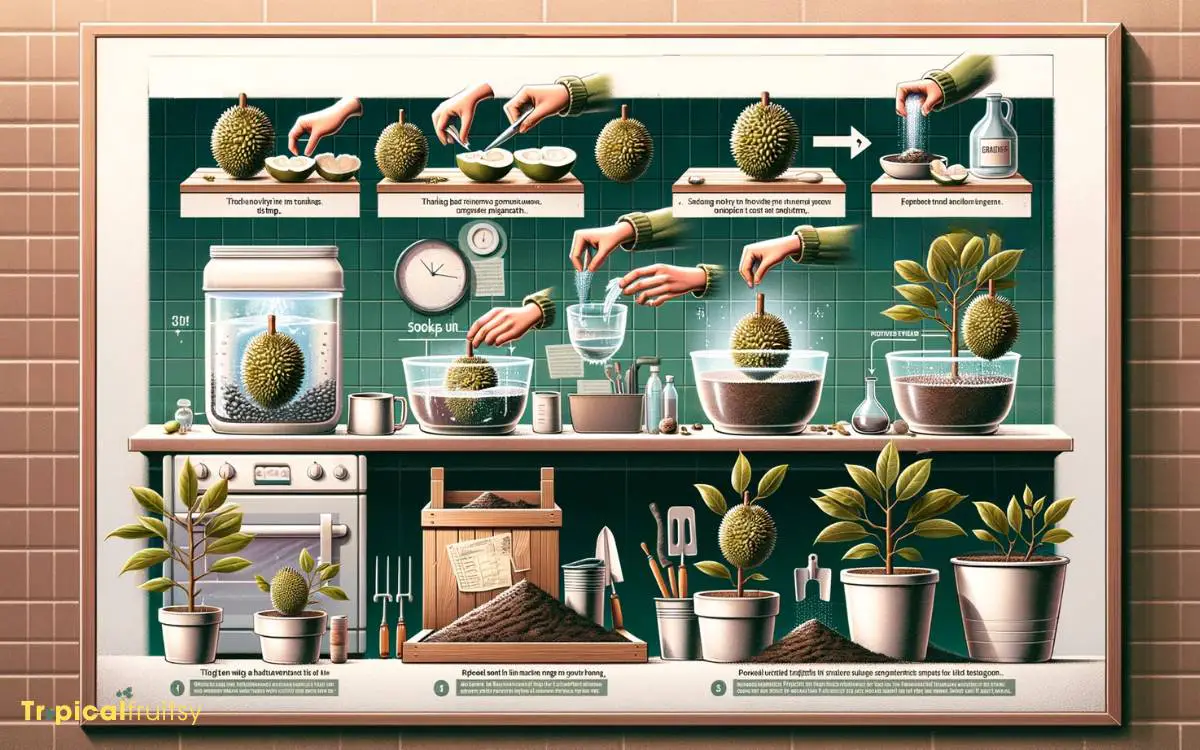
Growing durian from a frozen seed is possible, but it requires some extra care and attention compared to using fresh seeds.
Here are the steps to grow durian from a frozen seed:
Materials You’ll Need:
- Frozen durian seeds
- Airtight container or plastic bag
- Potting mix (well-draining)
- Planting pots or trays
- Plastic wrap or a plastic dome
- Watering can or spray bottle
- Warm and humid environment (such as a greenhouse or a warm room)
- Grow lights (optional, but helpful for providing consistent lighting)
Steps:
- Thaw the Seeds: Start by allowing the frozen durian seeds to thaw naturally at room temperature. This may take a few hours to a day. Make sure they are completely thawed before proceeding.
- Prepare the Seeds: Remove the outer husk or shell from the durian seeds. Be gentle to avoid damaging the seeds. You should be left with the inner seed.
- Soak the Seeds: Place the seeds in a container of water and soak them for about 24 to 48 hours. This helps to soften the seeds and improve germination rates.
- Prepare the Planting Mix: Use a well-draining potting mix that is suitable for tropical fruit trees. Fill your planting pots or trays with this mix, leaving about an inch of space at the top.
- Plant the Seeds: Plant the durian seeds about 1 inch deep in the planting mix. Place them horizontally with the flat side down. You can plant multiple seeds in each pot or tray, but make sure they are at least a few inches apart.
- Cover and Maintain Moisture: Cover the planting pots or trays with plastic wrap or a plastic dome to create a humid environment. Keep the soil consistently moist but not waterlogged. Use a spray bottle for gentle watering to avoid disturbing the seeds.
- Provide Warmth: Durian seeds require warm temperatures to germinate successfully. Aim to keep the environment consistently warm, ideally around 80-85°F (27-30°C). You may need a heating mat to maintain the temperature.
- Lighting: While durian seeds can germinate in low light, providing consistent lighting with grow lights can help ensure healthy growth once the seedlings emerge.
- Germination: Germination can take anywhere from several weeks to a few months. Be patient and continue to monitor soil moisture and temperature during this period.
- Transplant Seedlings: Once the seedlings have developed several leaves and are large enough to handle, transplant them into individual pots with well-draining soil. Continue to provide warmth, humidity, and adequate light.
- Harden Off and Plant Outdoors: As the seedlings grow and become more robust, gradually acclimate them to outdoor conditions by placing them outside for increasing periods each day. Once they are sturdy and have grown to a suitable size, transplant them into your desired location in a tropical or subtropical climate.
Please note that durian trees can take several years to produce fruit, and they require a tropical or subtropical climate with consistent warmth and high humidity.
Additionally, growing durian from seeds may result in variability in fruit quality, as durian trees often produce fruit with characteristics different from the parent tree.
Conclusion
Successful durian seed germination hinges on meticulous adherence to best practices in seed selection, preparation, and sowing. This should be coupled with the provision of optimal soil and environmental conditions.
The juxtaposition of technical rigor and the nurturing patience required underscores the delicate balance between scientific precision and the art of cultivation.
Cultivators must vigilantly monitor and nurture these emergent saplings. They need to guide them through to fruitful maturity with strategic care.


